Contemporary Management: Social Sustainability in the Textile Industry
VerifiedAdded on 2023/01/16
|9
|2228
|76
Report
AI Summary
This report delves into the critical issues of social sustainability within the textile and clothing industry, with a particular focus on the challenges and regulations faced by developing countries. It highlights pressing concerns such as labor conditions, child labor, human rights, and workplace safety, often exacerbated by outsourcing practices and the pressure for low prices. The report explores the social impact of outsourcing, emphasizing the ethical responsibilities of companies and the importance of adhering to social standards. It examines various regulations and practices, including the role of certifications, auditing, and the significance of corporate reputation in ensuring ethical sourcing and sustainable manufacturing processes. The report also evaluates the sources used, assessing their currency, relevance, authority, and accuracy in supporting the arguments presented. The conclusion underscores the need for companies to prioritize ethical business ties, emphasizing the eradication of child labor, fair treatment of workers, and the maintenance of integrity in management.
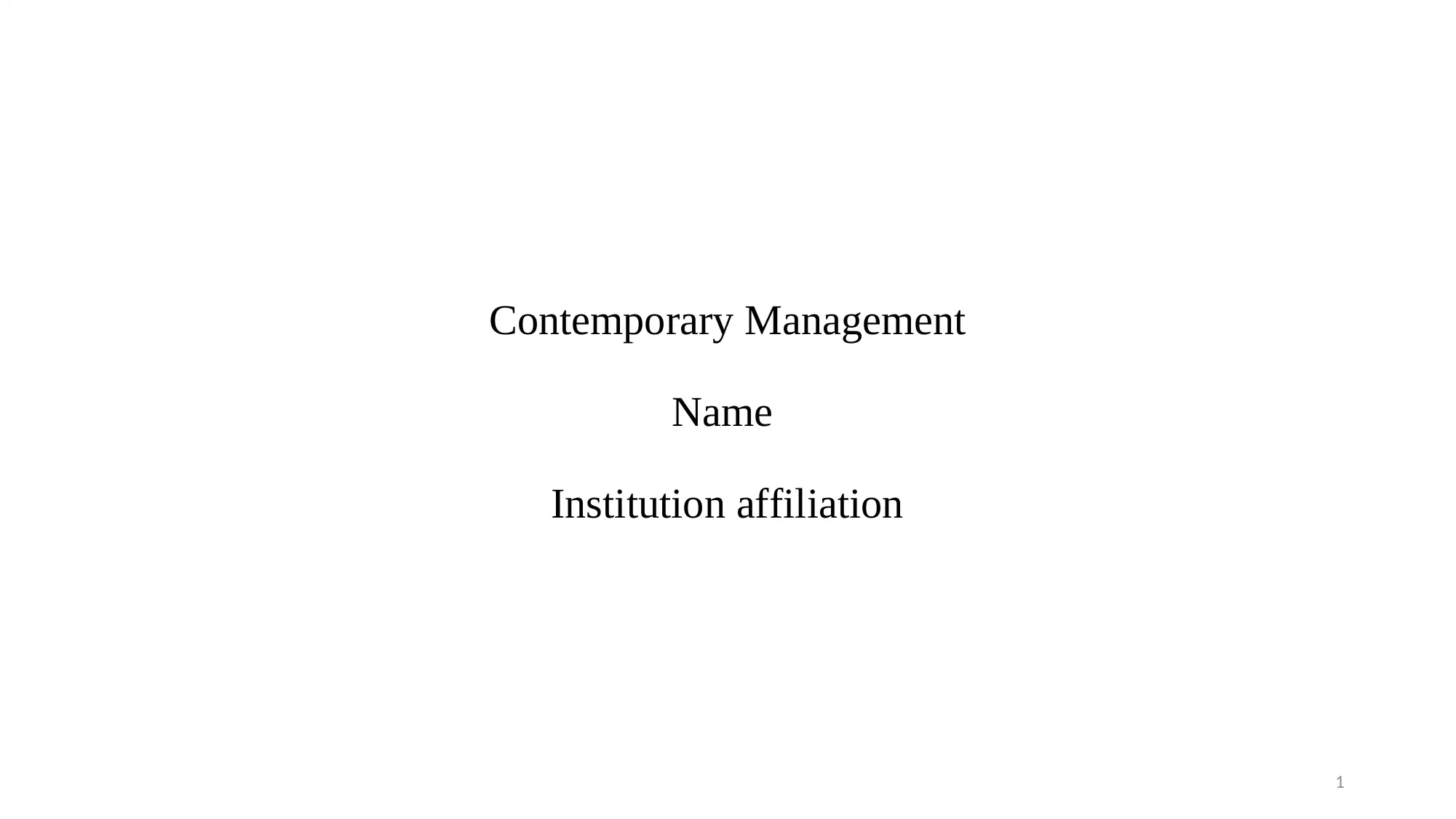
Contemporary Management
Name
Institution affiliation
1
Name
Institution affiliation
1
Paraphrase This Document
Need a fresh take? Get an instant paraphrase of this document with our AI Paraphraser
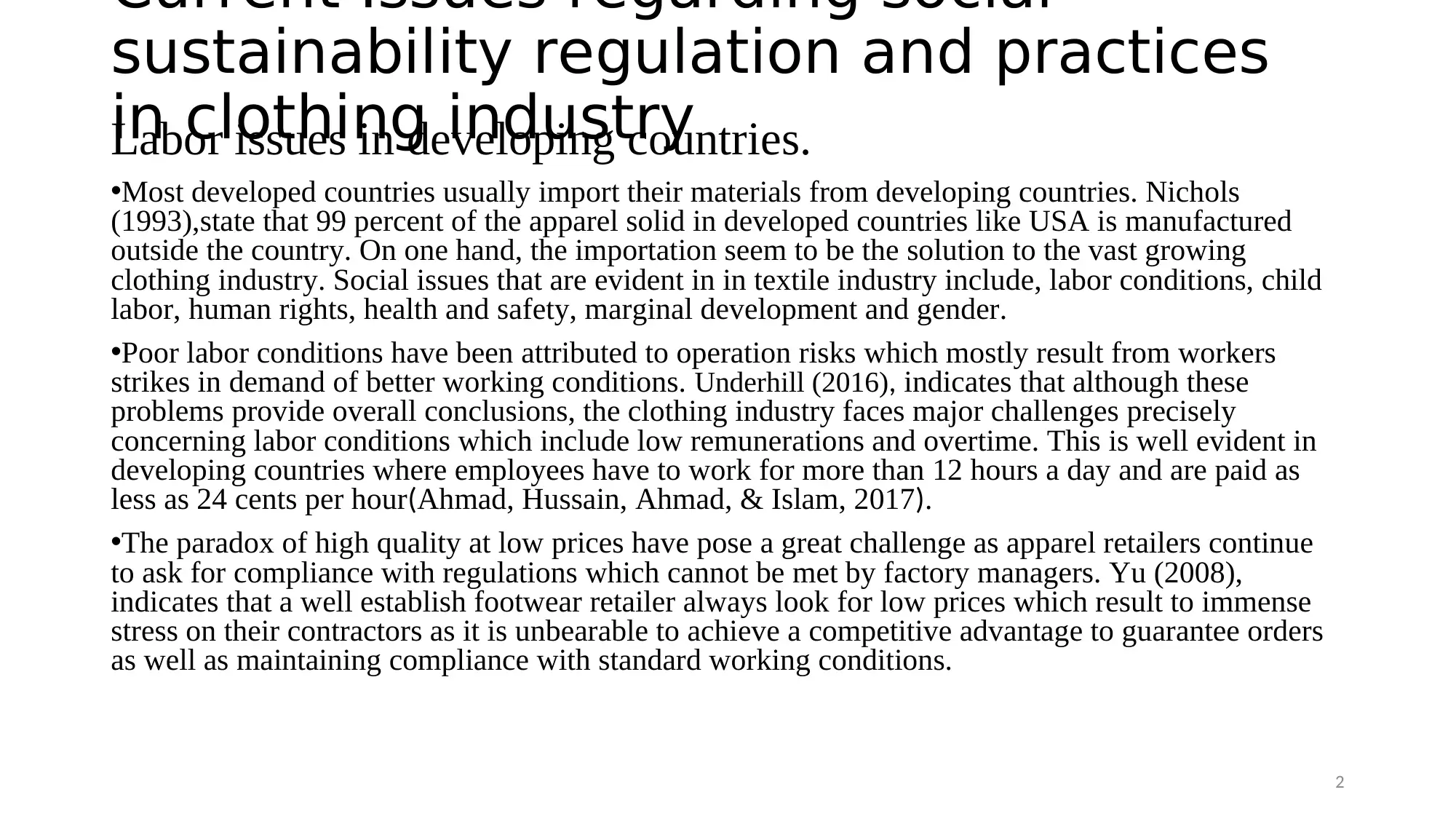
Current Issues regarding social
sustainability regulation and practices
in clothing industryLabor issues in developing countries.
•Most developed countries usually import their materials from developing countries. Nichols
(1993),state that 99 percent of the apparel solid in developed countries like USA is manufactured
outside the country. On one hand, the importation seem to be the solution to the vast growing
clothing industry. Social issues that are evident in in textile industry include, labor conditions, child
labor, human rights, health and safety, marginal development and gender.
•Poor labor conditions have been attributed to operation risks which mostly result from workers
strikes in demand of better working conditions. Underhill (2016), indicates that although these
problems provide overall conclusions, the clothing industry faces major challenges precisely
concerning labor conditions which include low remunerations and overtime. This is well evident in
developing countries where employees have to work for more than 12 hours a day and are paid as
less as 24 cents per hour(Ahmad, Hussain, Ahmad, & Islam, 2017).
•The paradox of high quality at low prices have pose a great challenge as apparel retailers continue
to ask for compliance with regulations which cannot be met by factory managers. Yu (2008),
indicates that a well establish footwear retailer always look for low prices which result to immense
stress on their contractors as it is unbearable to achieve a competitive advantage to guarantee orders
as well as maintaining compliance with standard working conditions.
2
sustainability regulation and practices
in clothing industryLabor issues in developing countries.
•Most developed countries usually import their materials from developing countries. Nichols
(1993),state that 99 percent of the apparel solid in developed countries like USA is manufactured
outside the country. On one hand, the importation seem to be the solution to the vast growing
clothing industry. Social issues that are evident in in textile industry include, labor conditions, child
labor, human rights, health and safety, marginal development and gender.
•Poor labor conditions have been attributed to operation risks which mostly result from workers
strikes in demand of better working conditions. Underhill (2016), indicates that although these
problems provide overall conclusions, the clothing industry faces major challenges precisely
concerning labor conditions which include low remunerations and overtime. This is well evident in
developing countries where employees have to work for more than 12 hours a day and are paid as
less as 24 cents per hour(Ahmad, Hussain, Ahmad, & Islam, 2017).
•The paradox of high quality at low prices have pose a great challenge as apparel retailers continue
to ask for compliance with regulations which cannot be met by factory managers. Yu (2008),
indicates that a well establish footwear retailer always look for low prices which result to immense
stress on their contractors as it is unbearable to achieve a competitive advantage to guarantee orders
as well as maintaining compliance with standard working conditions.
2
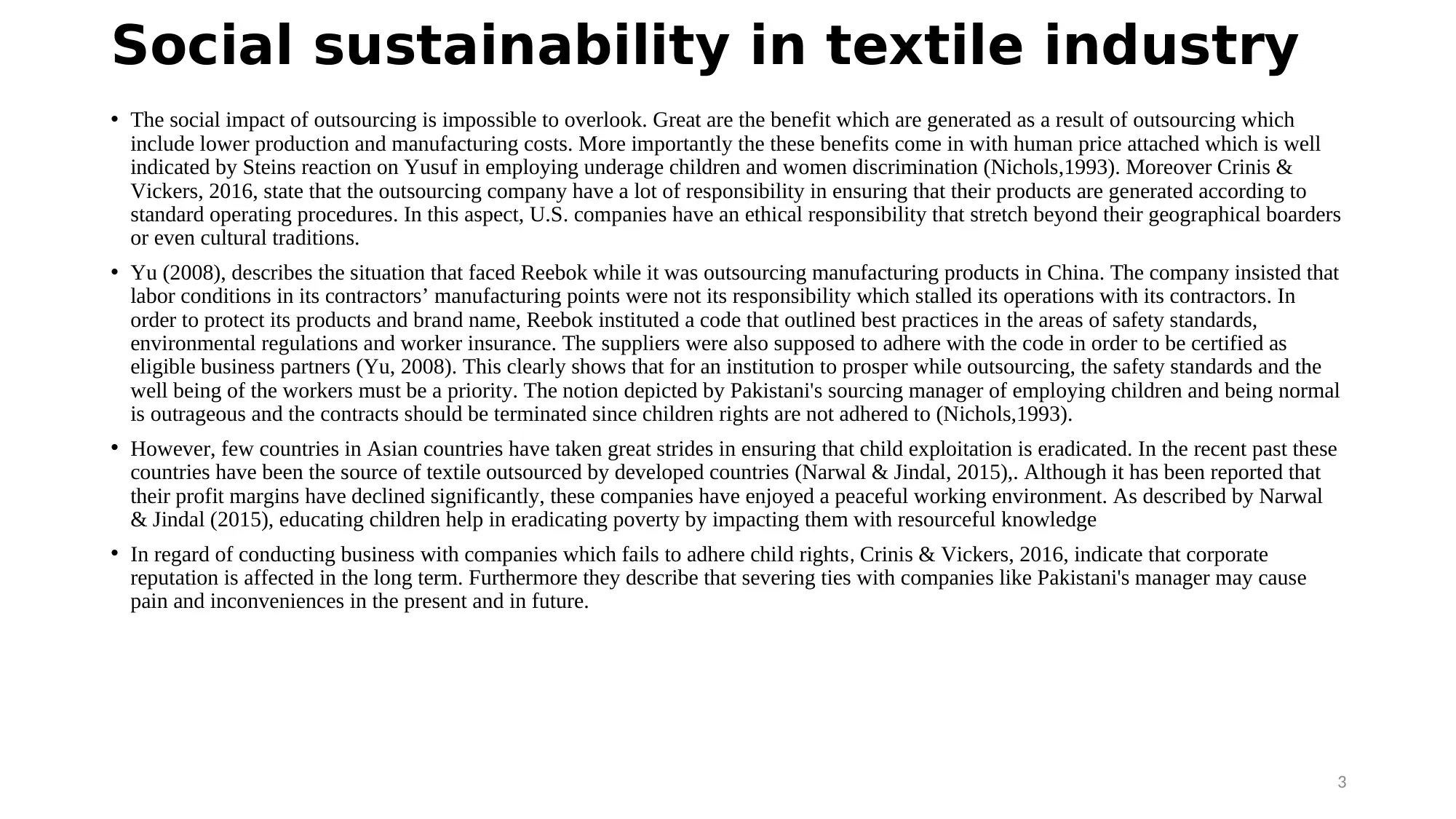
Social sustainability in textile industry
• The social impact of outsourcing is impossible to overlook. Great are the benefit which are generated as a result of outsourcing which
include lower production and manufacturing costs. More importantly the these benefits come in with human price attached which is well
indicated by Steins reaction on Yusuf in employing underage children and women discrimination (Nichols,1993). Moreover Crinis &
Vickers, 2016, state that the outsourcing company have a lot of responsibility in ensuring that their products are generated according to
standard operating procedures. In this aspect, U.S. companies have an ethical responsibility that stretch beyond their geographical boarders
or even cultural traditions.
• Yu (2008), describes the situation that faced Reebok while it was outsourcing manufacturing products in China. The company insisted that
labor conditions in its contractors’ manufacturing points were not its responsibility which stalled its operations with its contractors. In
order to protect its products and brand name, Reebok instituted a code that outlined best practices in the areas of safety standards,
environmental regulations and worker insurance. The suppliers were also supposed to adhere with the code in order to be certified as
eligible business partners (Yu, 2008). This clearly shows that for an institution to prosper while outsourcing, the safety standards and the
well being of the workers must be a priority. The notion depicted by Pakistani's sourcing manager of employing children and being normal
is outrageous and the contracts should be terminated since children rights are not adhered to (Nichols,1993).
• However, few countries in Asian countries have taken great strides in ensuring that child exploitation is eradicated. In the recent past these
countries have been the source of textile outsourced by developed countries (Narwal & Jindal, 2015),. Although it has been reported that
their profit margins have declined significantly, these companies have enjoyed a peaceful working environment. As described by Narwal
& Jindal (2015), educating children help in eradicating poverty by impacting them with resourceful knowledge
• In regard of conducting business with companies which fails to adhere child rights, Crinis & Vickers, 2016, indicate that corporate
reputation is affected in the long term. Furthermore they describe that severing ties with companies like Pakistani's manager may cause
pain and inconveniences in the present and in future.
3
• The social impact of outsourcing is impossible to overlook. Great are the benefit which are generated as a result of outsourcing which
include lower production and manufacturing costs. More importantly the these benefits come in with human price attached which is well
indicated by Steins reaction on Yusuf in employing underage children and women discrimination (Nichols,1993). Moreover Crinis &
Vickers, 2016, state that the outsourcing company have a lot of responsibility in ensuring that their products are generated according to
standard operating procedures. In this aspect, U.S. companies have an ethical responsibility that stretch beyond their geographical boarders
or even cultural traditions.
• Yu (2008), describes the situation that faced Reebok while it was outsourcing manufacturing products in China. The company insisted that
labor conditions in its contractors’ manufacturing points were not its responsibility which stalled its operations with its contractors. In
order to protect its products and brand name, Reebok instituted a code that outlined best practices in the areas of safety standards,
environmental regulations and worker insurance. The suppliers were also supposed to adhere with the code in order to be certified as
eligible business partners (Yu, 2008). This clearly shows that for an institution to prosper while outsourcing, the safety standards and the
well being of the workers must be a priority. The notion depicted by Pakistani's sourcing manager of employing children and being normal
is outrageous and the contracts should be terminated since children rights are not adhered to (Nichols,1993).
• However, few countries in Asian countries have taken great strides in ensuring that child exploitation is eradicated. In the recent past these
countries have been the source of textile outsourced by developed countries (Narwal & Jindal, 2015),. Although it has been reported that
their profit margins have declined significantly, these companies have enjoyed a peaceful working environment. As described by Narwal
& Jindal (2015), educating children help in eradicating poverty by impacting them with resourceful knowledge
• In regard of conducting business with companies which fails to adhere child rights, Crinis & Vickers, 2016, indicate that corporate
reputation is affected in the long term. Furthermore they describe that severing ties with companies like Pakistani's manager may cause
pain and inconveniences in the present and in future.
3
⊘ This is a preview!⊘
Do you want full access?
Subscribe today to unlock all pages.

Trusted by 1+ million students worldwide
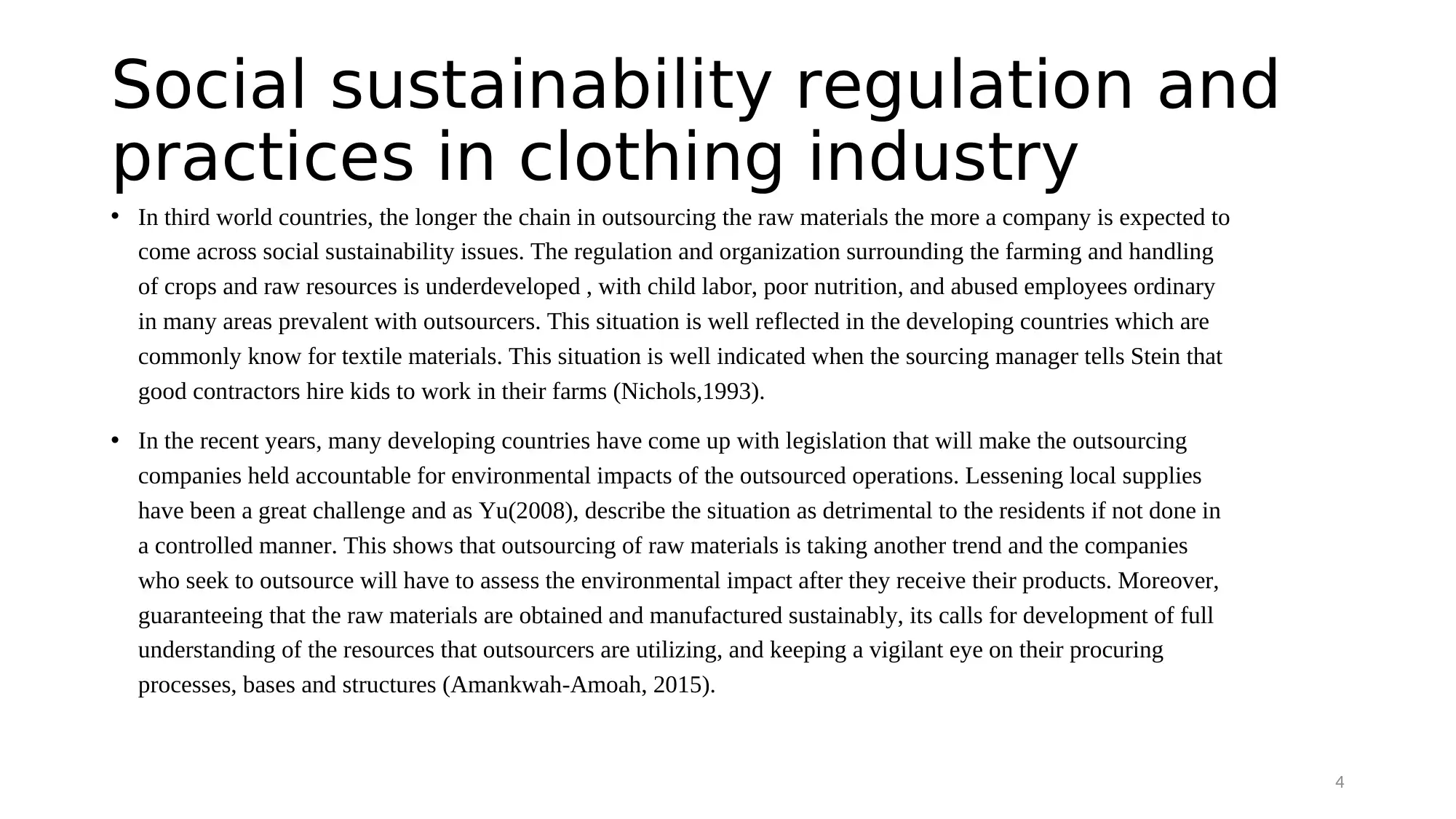
Social sustainability regulation and
practices in clothing industry
• In third world countries, the longer the chain in outsourcing the raw materials the more a company is expected to
come across social sustainability issues. The regulation and organization surrounding the farming and handling
of crops and raw resources is underdeveloped , with child labor, poor nutrition, and abused employees ordinary
in many areas prevalent with outsourcers. This situation is well reflected in the developing countries which are
commonly know for textile materials. This situation is well indicated when the sourcing manager tells Stein that
good contractors hire kids to work in their farms (Nichols,1993).
• In the recent years, many developing countries have come up with legislation that will make the outsourcing
companies held accountable for environmental impacts of the outsourced operations. Lessening local supplies
have been a great challenge and as Yu(2008), describe the situation as detrimental to the residents if not done in
a controlled manner. This shows that outsourcing of raw materials is taking another trend and the companies
who seek to outsource will have to assess the environmental impact after they receive their products. Moreover,
guaranteeing that the raw materials are obtained and manufactured sustainably, its calls for development of full
understanding of the resources that outsourcers are utilizing, and keeping a vigilant eye on their procuring
processes, bases and structures (Amankwah-Amoah, 2015).
4
practices in clothing industry
• In third world countries, the longer the chain in outsourcing the raw materials the more a company is expected to
come across social sustainability issues. The regulation and organization surrounding the farming and handling
of crops and raw resources is underdeveloped , with child labor, poor nutrition, and abused employees ordinary
in many areas prevalent with outsourcers. This situation is well reflected in the developing countries which are
commonly know for textile materials. This situation is well indicated when the sourcing manager tells Stein that
good contractors hire kids to work in their farms (Nichols,1993).
• In the recent years, many developing countries have come up with legislation that will make the outsourcing
companies held accountable for environmental impacts of the outsourced operations. Lessening local supplies
have been a great challenge and as Yu(2008), describe the situation as detrimental to the residents if not done in
a controlled manner. This shows that outsourcing of raw materials is taking another trend and the companies
who seek to outsource will have to assess the environmental impact after they receive their products. Moreover,
guaranteeing that the raw materials are obtained and manufactured sustainably, its calls for development of full
understanding of the resources that outsourcers are utilizing, and keeping a vigilant eye on their procuring
processes, bases and structures (Amankwah-Amoah, 2015).
4
Paraphrase This Document
Need a fresh take? Get an instant paraphrase of this document with our AI Paraphraser
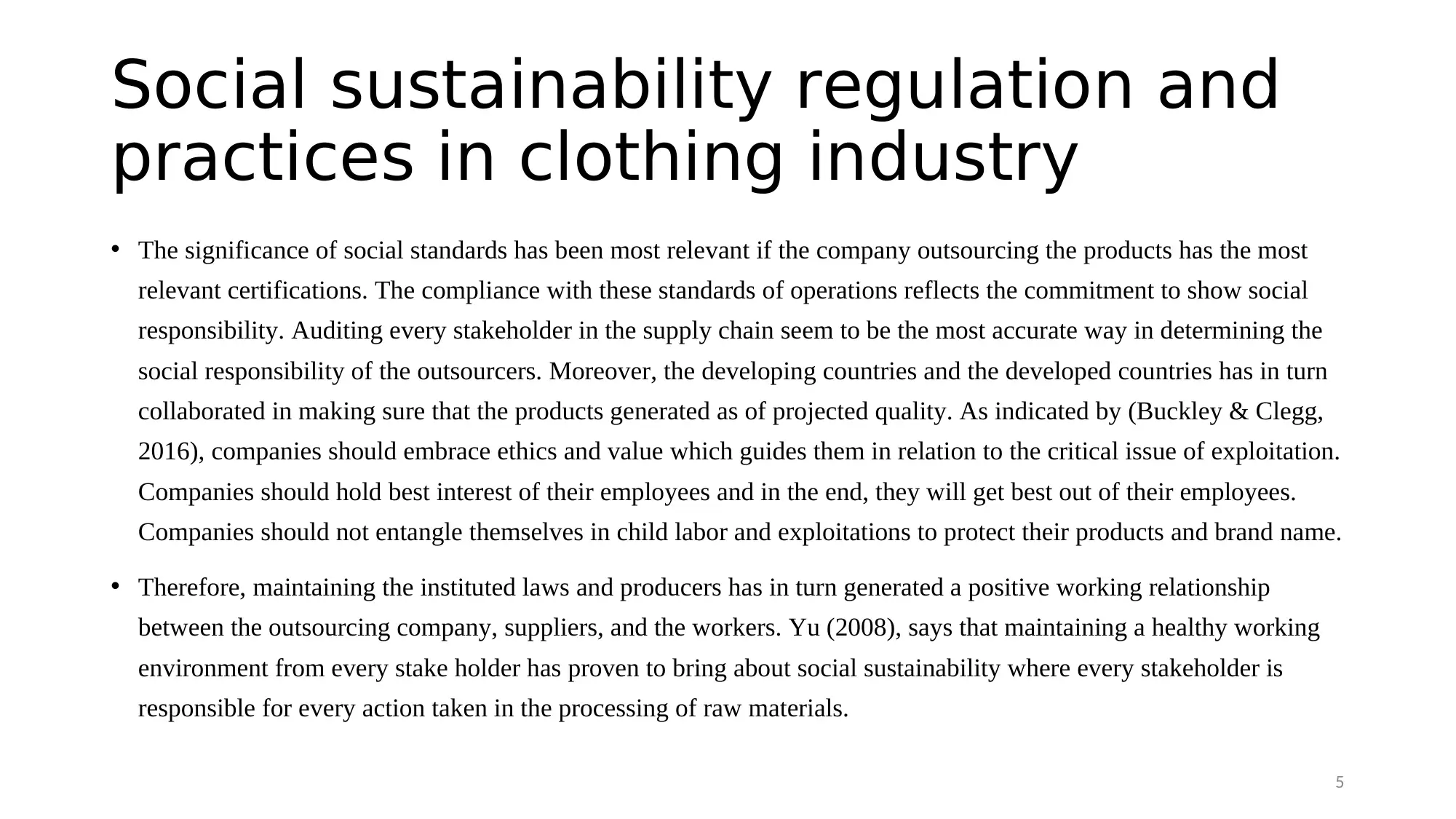
Social sustainability regulation and
practices in clothing industry
• The significance of social standards has been most relevant if the company outsourcing the products has the most
relevant certifications. The compliance with these standards of operations reflects the commitment to show social
responsibility. Auditing every stakeholder in the supply chain seem to be the most accurate way in determining the
social responsibility of the outsourcers. Moreover, the developing countries and the developed countries has in turn
collaborated in making sure that the products generated as of projected quality. As indicated by (Buckley & Clegg,
2016), companies should embrace ethics and value which guides them in relation to the critical issue of exploitation.
Companies should hold best interest of their employees and in the end, they will get best out of their employees.
Companies should not entangle themselves in child labor and exploitations to protect their products and brand name.
• Therefore, maintaining the instituted laws and producers has in turn generated a positive working relationship
between the outsourcing company, suppliers, and the workers. Yu (2008), says that maintaining a healthy working
environment from every stake holder has proven to bring about social sustainability where every stakeholder is
responsible for every action taken in the processing of raw materials.
5
practices in clothing industry
• The significance of social standards has been most relevant if the company outsourcing the products has the most
relevant certifications. The compliance with these standards of operations reflects the commitment to show social
responsibility. Auditing every stakeholder in the supply chain seem to be the most accurate way in determining the
social responsibility of the outsourcers. Moreover, the developing countries and the developed countries has in turn
collaborated in making sure that the products generated as of projected quality. As indicated by (Buckley & Clegg,
2016), companies should embrace ethics and value which guides them in relation to the critical issue of exploitation.
Companies should hold best interest of their employees and in the end, they will get best out of their employees.
Companies should not entangle themselves in child labor and exploitations to protect their products and brand name.
• Therefore, maintaining the instituted laws and producers has in turn generated a positive working relationship
between the outsourcing company, suppliers, and the workers. Yu (2008), says that maintaining a healthy working
environment from every stake holder has proven to bring about social sustainability where every stakeholder is
responsible for every action taken in the processing of raw materials.
5
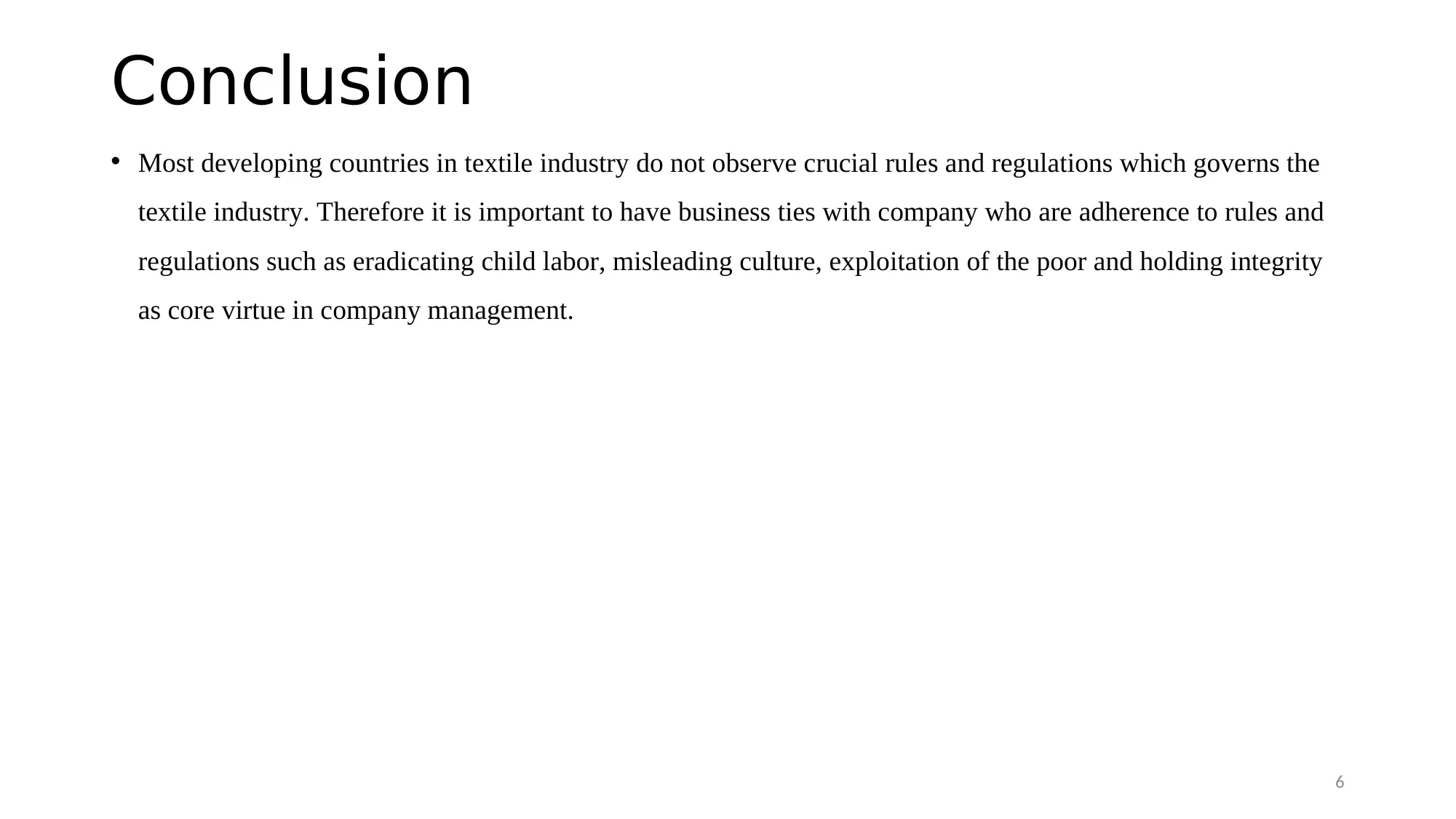
Conclusion
• Most developing countries in textile industry do not observe crucial rules and regulations which governs the
textile industry. Therefore it is important to have business ties with company who are adherence to rules and
regulations such as eradicating child labor, misleading culture, exploitation of the poor and holding integrity
as core virtue in company management.
6
• Most developing countries in textile industry do not observe crucial rules and regulations which governs the
textile industry. Therefore it is important to have business ties with company who are adherence to rules and
regulations such as eradicating child labor, misleading culture, exploitation of the poor and holding integrity
as core virtue in company management.
6
⊘ This is a preview!⊘
Do you want full access?
Subscribe today to unlock all pages.

Trusted by 1+ million students worldwide
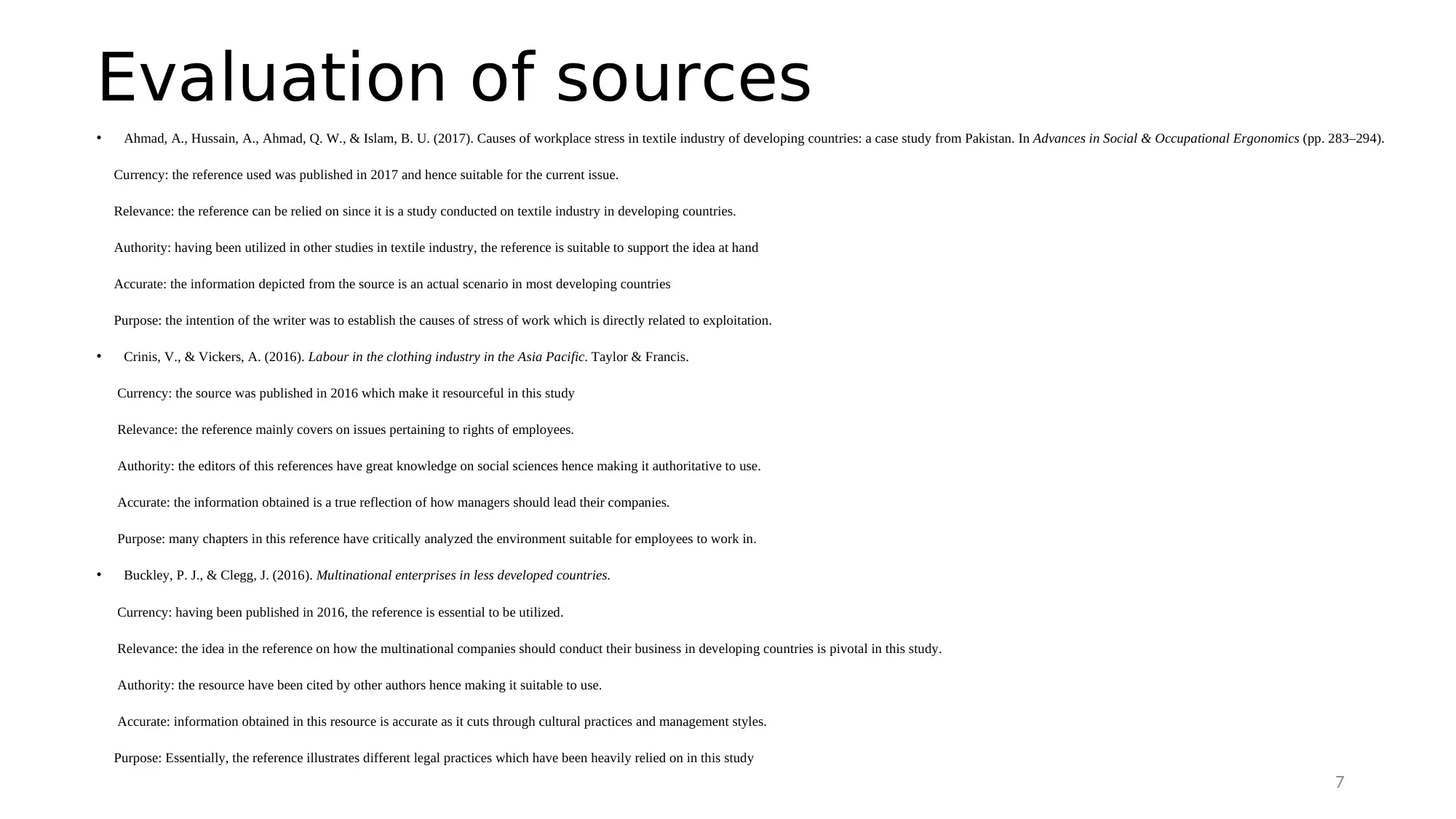
Evaluation of sources
• Ahmad, A., Hussain, A., Ahmad, Q. W., & Islam, B. U. (2017). Causes of workplace stress in textile industry of developing countries: a case study from Pakistan. In Advances in Social & Occupational Ergonomics (pp. 283–294).
Currency: the reference used was published in 2017 and hence suitable for the current issue.
Relevance: the reference can be relied on since it is a study conducted on textile industry in developing countries.
Authority: having been utilized in other studies in textile industry, the reference is suitable to support the idea at hand
Accurate: the information depicted from the source is an actual scenario in most developing countries
Purpose: the intention of the writer was to establish the causes of stress of work which is directly related to exploitation.
• Crinis, V., & Vickers, A. (2016). Labour in the clothing industry in the Asia Pacific. Taylor & Francis.
Currency: the source was published in 2016 which make it resourceful in this study
Relevance: the reference mainly covers on issues pertaining to rights of employees.
Authority: the editors of this references have great knowledge on social sciences hence making it authoritative to use.
Accurate: the information obtained is a true reflection of how managers should lead their companies.
Purpose: many chapters in this reference have critically analyzed the environment suitable for employees to work in.
• Buckley, P. J., & Clegg, J. (2016). Multinational enterprises in less developed countries.
Currency: having been published in 2016, the reference is essential to be utilized.
Relevance: the idea in the reference on how the multinational companies should conduct their business in developing countries is pivotal in this study.
Authority: the resource have been cited by other authors hence making it suitable to use.
Accurate: information obtained in this resource is accurate as it cuts through cultural practices and management styles.
Purpose: Essentially, the reference illustrates different legal practices which have been heavily relied on in this study
7
• Ahmad, A., Hussain, A., Ahmad, Q. W., & Islam, B. U. (2017). Causes of workplace stress in textile industry of developing countries: a case study from Pakistan. In Advances in Social & Occupational Ergonomics (pp. 283–294).
Currency: the reference used was published in 2017 and hence suitable for the current issue.
Relevance: the reference can be relied on since it is a study conducted on textile industry in developing countries.
Authority: having been utilized in other studies in textile industry, the reference is suitable to support the idea at hand
Accurate: the information depicted from the source is an actual scenario in most developing countries
Purpose: the intention of the writer was to establish the causes of stress of work which is directly related to exploitation.
• Crinis, V., & Vickers, A. (2016). Labour in the clothing industry in the Asia Pacific. Taylor & Francis.
Currency: the source was published in 2016 which make it resourceful in this study
Relevance: the reference mainly covers on issues pertaining to rights of employees.
Authority: the editors of this references have great knowledge on social sciences hence making it authoritative to use.
Accurate: the information obtained is a true reflection of how managers should lead their companies.
Purpose: many chapters in this reference have critically analyzed the environment suitable for employees to work in.
• Buckley, P. J., & Clegg, J. (2016). Multinational enterprises in less developed countries.
Currency: having been published in 2016, the reference is essential to be utilized.
Relevance: the idea in the reference on how the multinational companies should conduct their business in developing countries is pivotal in this study.
Authority: the resource have been cited by other authors hence making it suitable to use.
Accurate: information obtained in this resource is accurate as it cuts through cultural practices and management styles.
Purpose: Essentially, the reference illustrates different legal practices which have been heavily relied on in this study
7
Paraphrase This Document
Need a fresh take? Get an instant paraphrase of this document with our AI Paraphraser

Evaluation of sources• Underhill, G. (2016). Industrial crisis and the open economy: politics, global trade and the textile industry in the advanced economies.
Currency: Published in 2016, the reference is useful in this study
Relevance: The reference focuses on the practices that the developing countries should incorporate for maximum production
Authority: the reference cuts through polices in which must be embraced hence making it important to be utilized
Accurate: the information obtained is clear since its not biased
Purpose: the reference seeks to impact on the scholars with policies governing economies
• Narwal, K. P., & Jindal, S. (2015). The impact of corporate governance on the profitability: An empirical study of Indian textile
industry. International Journal of Research in Management, Science & Technology, 3(2), 81–85.
Currency: the reference being published in 2015 is clearly useful
Relevance: Since the authors describe almost the same scenario with the sourcing manager, its therefore useful to utilize in this study
Authority: the author’s journal has been cited by other authors hence making it useful in this study.
Accurate: the information shared in the reference is accurate and free from bias
Purpose: the purpose of this journal is to enlighten the scholars on the importance of good governance which has a positive correlation
with profitability.
8
Currency: Published in 2016, the reference is useful in this study
Relevance: The reference focuses on the practices that the developing countries should incorporate for maximum production
Authority: the reference cuts through polices in which must be embraced hence making it important to be utilized
Accurate: the information obtained is clear since its not biased
Purpose: the reference seeks to impact on the scholars with policies governing economies
• Narwal, K. P., & Jindal, S. (2015). The impact of corporate governance on the profitability: An empirical study of Indian textile
industry. International Journal of Research in Management, Science & Technology, 3(2), 81–85.
Currency: the reference being published in 2015 is clearly useful
Relevance: Since the authors describe almost the same scenario with the sourcing manager, its therefore useful to utilize in this study
Authority: the author’s journal has been cited by other authors hence making it useful in this study.
Accurate: the information shared in the reference is accurate and free from bias
Purpose: the purpose of this journal is to enlighten the scholars on the importance of good governance which has a positive correlation
with profitability.
8
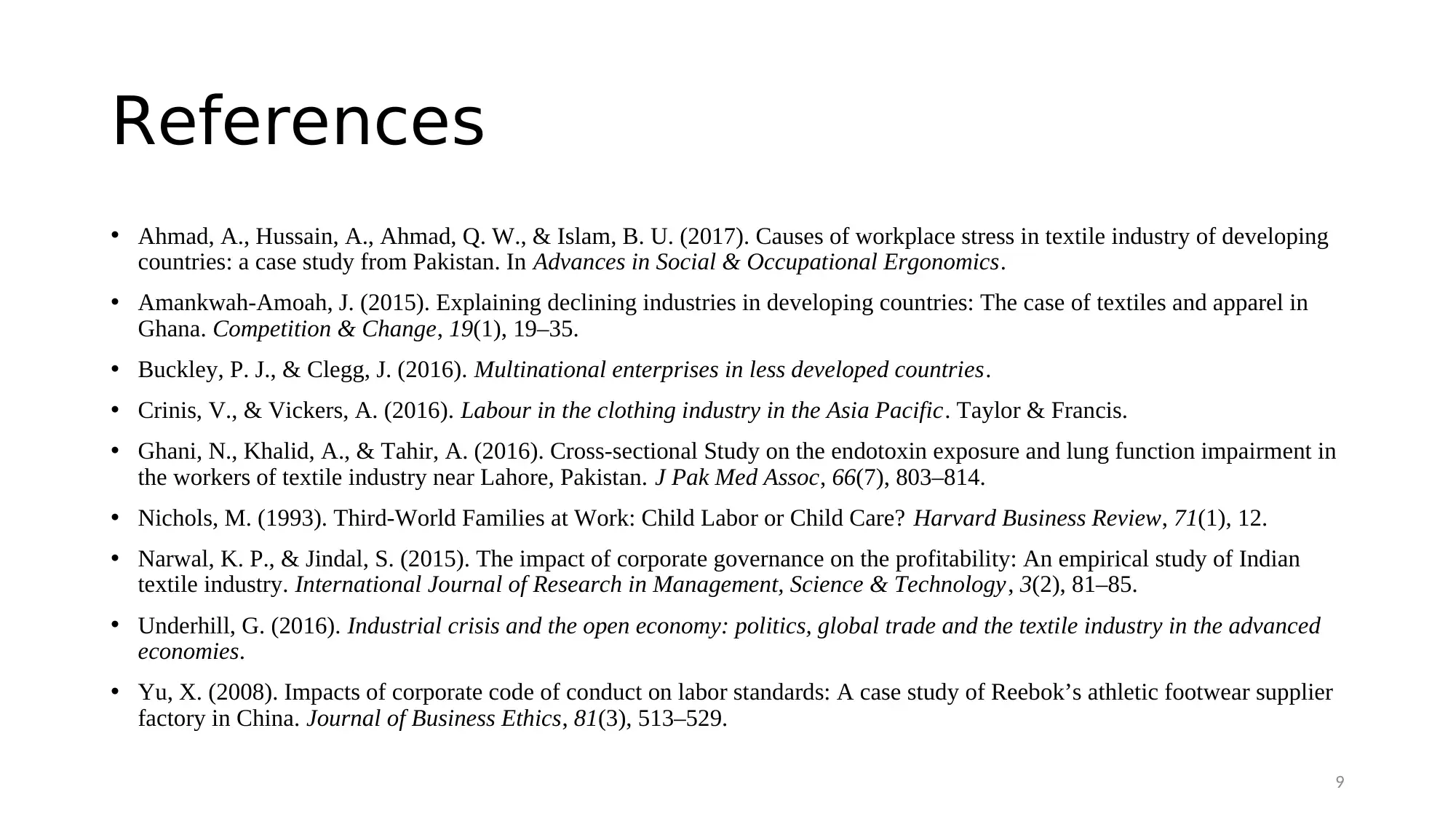
References
• Ahmad, A., Hussain, A., Ahmad, Q. W., & Islam, B. U. (2017). Causes of workplace stress in textile industry of developing
countries: a case study from Pakistan. In Advances in Social & Occupational Ergonomics.
• Amankwah-Amoah, J. (2015). Explaining declining industries in developing countries: The case of textiles and apparel in
Ghana. Competition & Change, 19(1), 19–35.
• Buckley, P. J., & Clegg, J. (2016). Multinational enterprises in less developed countries.
• Crinis, V., & Vickers, A. (2016). Labour in the clothing industry in the Asia Pacific. Taylor & Francis.
• Ghani, N., Khalid, A., & Tahir, A. (2016). Cross-sectional Study on the endotoxin exposure and lung function impairment in
the workers of textile industry near Lahore, Pakistan. J Pak Med Assoc, 66(7), 803–814.
• Nichols, M. (1993). Third-World Families at Work: Child Labor or Child Care? Harvard Business Review, 71(1), 12.
• Narwal, K. P., & Jindal, S. (2015). The impact of corporate governance on the profitability: An empirical study of Indian
textile industry. International Journal of Research in Management, Science & Technology, 3(2), 81–85.
• Underhill, G. (2016). Industrial crisis and the open economy: politics, global trade and the textile industry in the advanced
economies.
• Yu, X. (2008). Impacts of corporate code of conduct on labor standards: A case study of Reebok’s athletic footwear supplier
factory in China. Journal of Business Ethics, 81(3), 513–529.
9
• Ahmad, A., Hussain, A., Ahmad, Q. W., & Islam, B. U. (2017). Causes of workplace stress in textile industry of developing
countries: a case study from Pakistan. In Advances in Social & Occupational Ergonomics.
• Amankwah-Amoah, J. (2015). Explaining declining industries in developing countries: The case of textiles and apparel in
Ghana. Competition & Change, 19(1), 19–35.
• Buckley, P. J., & Clegg, J. (2016). Multinational enterprises in less developed countries.
• Crinis, V., & Vickers, A. (2016). Labour in the clothing industry in the Asia Pacific. Taylor & Francis.
• Ghani, N., Khalid, A., & Tahir, A. (2016). Cross-sectional Study on the endotoxin exposure and lung function impairment in
the workers of textile industry near Lahore, Pakistan. J Pak Med Assoc, 66(7), 803–814.
• Nichols, M. (1993). Third-World Families at Work: Child Labor or Child Care? Harvard Business Review, 71(1), 12.
• Narwal, K. P., & Jindal, S. (2015). The impact of corporate governance on the profitability: An empirical study of Indian
textile industry. International Journal of Research in Management, Science & Technology, 3(2), 81–85.
• Underhill, G. (2016). Industrial crisis and the open economy: politics, global trade and the textile industry in the advanced
economies.
• Yu, X. (2008). Impacts of corporate code of conduct on labor standards: A case study of Reebok’s athletic footwear supplier
factory in China. Journal of Business Ethics, 81(3), 513–529.
9
⊘ This is a preview!⊘
Do you want full access?
Subscribe today to unlock all pages.

Trusted by 1+ million students worldwide
1 out of 9
Related Documents
Your All-in-One AI-Powered Toolkit for Academic Success.
+13062052269
info@desklib.com
Available 24*7 on WhatsApp / Email
![[object Object]](/_next/static/media/star-bottom.7253800d.svg)
Unlock your academic potential
Copyright © 2020–2025 A2Z Services. All Rights Reserved. Developed and managed by ZUCOL.




